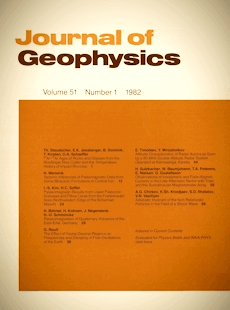Pi2 magnetic pulsations, auroral break-ups, and the substorm current wedge: A case study
Article Sidebar

Vols. 1-18 (1924-1944), ISSN 0044-2801
Main Article Content
Abstract
The two-dimensional distribution of the characteristics of Pi2 magnetic pulsations observed by the Scandinavian Magnetometer Array (SMA) during the passage of a westward travelling surge on 11 November 1976 and during three sucessive auroral break-ups around magnetic midnight on 15 February 1977 have been studied in relation to the position of active aurora and the break-up current system. On both days the greatest Pi2 amplitudes were collocated with the region where the brightest auroras were observed. The sense of polarization of the horizontal disturbance vectors changed along longitudinal and meridional lines. The two-dimensional equivalent current system of the Pi2 pulsations resembled a circular current vortex around the location of the localized upward field-aligned currents and changed its direction from counterclockwise to clockwise and back to counterclockwise again within one Pi2 cycle. Our observations indicate that the generation of Pi2 pulsations is not directly connected to periodic fluctuations of the complete current system at substorm onset, but that the upward directed field-aligned currents at the western edge of this system play the most important role for the Pi2 generation.
 ARK: https://n2t.net/ark:/88439/y071359
ARK: https://n2t.net/ark:/88439/y071359
Permalink: https://geophysicsjournal.com/article/167
Article Details
References
Beamish, D., Hanson, H.W., Webb, D.C. (1979) Complex demodulation applied to Pi2 geomagnetic pulsations. Geophys. J.R. Astron. Soc. 58:471-493
Bostrom, R. (1972) Magnetosphere-ionosphere coupling. In: Dyer, E.R. (Ed.) Critical Problems of Magnetospheric Physics, pp 139-156. IUCSTP Secretariat, National Academy of Sciences, Washington D.C.
Bostrom, R. (1974) Ionosphere-magnetosphere coupling. In: McCormac, B.M. (Ed.) Magnetospheric Physics, pp. 45-59. D. Reidel Publishing Company, Dordrecht-Boston
Bosinger, T., Alanko, K., Kangas, J. Opgenoorth, H., Baumjohann, W. (1981) Correlations between PiB type magnetic micropulsations, auroras and equivalent current structures during two isolated substorms. J. Atmos. Terr. Phys. 43:933-945
Chao, J .K., Heacock, R.R. (1980) Modulation of type Pi waves by temporal variations in ionospheric conductivity in a three-dimensional magnetosphere-ionosphere current system. Planet. Space Sci. 28:475-486
Greenwald, R.A., Weiss, W., Nielsen, E., Thomson, N.R. (1978) STARE: a new radar auroral backscatter experiment in Northern Scandinavia. Radio Sci. 13:1021-1039
Heacock, R.R., Hunsucker, R.D. (1981) Type Pi 1-2 magnetic field pulsations. Space Sci. Rev. 28:191-221
Hughes, W.J., Southwood, D.J. (1976) The screening of micropulsation signals by the atmosphere and ionosphere. J. Geophys. Res. 81:3234-3240
Koshelevsky, V.K., Raspopov, O.M., Starkov, G.V. (1972) The connection of parameters of geomagnetic pulsation Pi2 with the processes in the auroral zone (in Russian). Geomagn. Aeron. 12:886-891
Kuppers, F., Untiedt, J., Baumjohann, W., Lange, K., Jones, A.G. (1979) A two-dimensional magnetometer array for ground-based observations of auroral zone electric currents during the International
Magnetospheric Study (IMS). J. Geophys. 46:429-450
Kuwashima, M. (1978) Wave characteristics of magnetic Pi2 pulsations in the auroral region: spectral and polarization studies. Mem. Nat. Inst. Polar Res. Japan, Series A:15
Lanzerotti, L.J., Fukunishi, H. (1974) Modes of MHD waves in the magnetosphere. Rev. Geophys. Space Phys. 12:724-729
Lester, M., Orr, D. (1981) The spatio-temporal characteristics of Pi2's. J. Atmos. Terr. Phys. 43:947-974
Mallinckrodt, A.J., Carlson, C.W. (1978) Relations between transverse electric fields and field-aligned currents. J. Geophys. Res. 83:1426-1432
Maltsev, Yu.P., Leontyev, S.V., Lyatsky, W.B. (1974) Pi2 pulsations as a result of evolution of an Alfven impulse originating in the ionosphere during a brightening of aurora. Planet. Space Sci. 22:1519-1533
Maurer, H., Theile, B. (1978) Parameters of the auroral electrojet from magnetic variations along a meridian. J. Geophys. 44:415-426
Namgaladze, A.V., Raspopov, O.M., Roldugin, V.K. (1967) The correlation between Pi2 and auroral pulsations (in Russian). Geomagn. Aeron. 7:376-378
Nishida, A. (1979) Possible origin of transient dusk-to-dawn electric fields in the nightside magnetosphere. J. Geophys. Res. 84:3409-3419
Pellinen, R.J., Baumjohann, W., Heikkila, W.I., Sergeev, V.A., Yahnin, A.G., Marklund, G., Melnikov, A.O. (1982) Event study on presubstorm phases and their relation to the energy coupling between solar wind and magnetosphere. Planet. Space Sci. 30:371-388
Raspopov, O.M. (1967) Troitskaya, V.A., Schlich, R., Lisunkaya, I.S., Kazek, B.N., Koshelevsky, V.K.: Development of Pi2 magnetic pulsations at conjugate points (in Russian). Geomagn. Aeron. 7:858-868
Raspopov, O.M. (1976) Geomagnetic pulsations (in Russian). In: Pudovkin, M.I., Raspopov, O.M., Kleimenova, N.G. (Eds.) Disturbances of the electromagnetic field of the Earth, Vol. 2, Leningrad. Leningrad State University
Rostoker, G. (1967) The frequency spectrum of Pi2 micropulsation activity and its relationship to planetary magnetic activity. J. Geophys. Res. 72:2032-2039
Rostoker, G ., Samson, J.C. (1981) Polarization characteristics of Pi2 pulsations and implication for their source mechanism: Location of source regions with respect to the auroral electrojets. Planet. Space Sci. 29:225-247
Saito, T. (1961) Oscillation of geomagnetic field with the progress of pt-type pulsation. Sci. Rept. Tohoku Univ. 5, Geophys. 13:53
Sakurai, T., Saito, T. (1976) Magnetic pulsation Pi2 and substorm onset. Planet. Space Sci. 24:573-575
Samson, J.C. (1982) Pi2 pulsations: High latitude results. Planet. Space Sci. (In press)
Samson, J.C., Olson, J.V. (1981) Data adaptive polarization filters for multichannel geophysical data. Geophys. 46:1423-1431
Stuart, W.F. (1972) A special feature of impulsive pulsation (Pi2) J. Atmos. Terr. Phys. 34:829-836
Stuart, W.F., Green, C.A., Harris, T.J. (1977) Correlation between modulation of the intensity of precipitating electrons in the auroral zone and a coincident Pi2. J. Atmos. Terr. Phys. 39:631-635
Yahnin, A.G., Sergeev, V.A., Pellinen, R.J., Baumjohann, W., Ranta, H., Kangas, J., Raspopov, O.M. (1982) Substorm time sequence and microstructure on 11 November 1976. J. Geophys. (In press)











